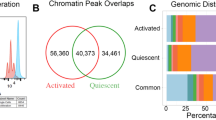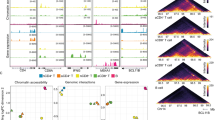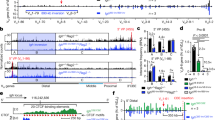Abstract
Cytokine genes undergo progressive changes in chromatin organization when naïve CD4+ T helper (Th) cells differentiate into committed Th1 and Th2 lineages. Here, we analyzed nuclear matrix attachment regions (MARs) in the Ifng gene by DNA array technique in unactivated and activated CD4+ Th cells. This approach was combined with analysis of spatial organization of the Ifng gene by chromosome conformation capture approach to assess the relationship between the gene conformation and matrix attachment organization in functionally different cell subsets. We report that the Ifng gene in unactivated cells displays a linear conformation, but in T-cell receptor-activated cells, it adopts a loop conformation. The selective MARs support the spatial gene organization and characteristically define the Ifng gene in functionally different cell subsets. The pattern of interaction of the Ifng gene with the nuclear matrix dynamically changes in a lineage-specific manner in parallel with the changes in Ifng gene conformation. The data suggest that such structural dynamics provide the means for transcriptional regulation of the Ifng gene in the course of activation and differentiation of CD4+Th cells.
This is a preview of subscription content, access via your institution
Access options
Subscribe to this journal
Receive 6 digital issues and online access to articles
$119.00 per year
only $19.83 per issue
Buy this article
- Purchase on Springer Link
- Instant access to full article PDF
Prices may be subject to local taxes which are calculated during checkout






Similar content being viewed by others
References
Zaidi SK, Young DW, Choi JY, Pratap J, Javed A, Montecino M et al. The dynamic organization of gene-regulatory machinery in nuclear microenvironments. EMBO 2005; 6: 128–133.
Martins RP, Ostermeier GC, Krawetz SA . Nuclear matrix interactions at the human protamine domain. J Biol Chem 2004; 279: 51862–51868.
Dekker J, Rippe K, Dekker M, Kleckner N . Capturing chromosome conformation. Science 2002; 295: 1306–1311.
Eivazova ER, Aune TM . Dynamic alterations in the conformation of the Ifng gene region during T helper cell differentiation. Proc Natl Acad Sci USA 2004; 101: 251–256.
Tolhuis B, Palstra RJ, Splinter E, Grosveld F, de Laat W . Looping and interaction between hypersensitive sites in the active β-globin locus. Mol Cell 2002; 10: 1453–1465.
Spilianakis CG, Flavell RA . Long-range intrachromosomal interactions in the T helper type 2 cytokine locus. Nat Immunol 2004; 5: 1017–1027.
de Laat W, Grosveld F . Spatial organization of gene expression: the active chromatin hub. Chromosome Res 2003; 11: 447–459.
Drissen RR, Palstra RJ, Gillemans N, Splinter E, Grosveld F, Philipsen S et al. The active spatial organization of the beta-globin locus requires the transcription factor EKLF. Genes Dev 2004; 18: 2485–2490.
Patrinos GP, de Krom M, de Boer E, Langeveld A, Imam AM, Strouboulis J et al. Multiple interactions between regulatory regions are required to stabilize an active chromatin hub. Genes Dev 2004; 18: 1495–1509.
Lee GR, Spilianakis CG, Flavell RA . Hypersensitive site 7 of the Th2 locus control region is essential for expressing Th2 cytokine genes and for long-range intrachromosomal interactions. Nat Immunol 2004; 6: 42–48.
Flavell RA . The molecular basis of T cell differentiation. Immunol Res 1999; 19: 159–168.
Glimcher LH, Murphy KM . Lineage commitment in the immune system: the T helper lymphocyte grows up. Genes Dev 2000; 14: 1693–1711.
Grogan JL, Mohrs M, Harmon B, Lacy DA, Sedat JW, Locksley RM . Early transcription and silencing of cytokine genes underlie polarization of T helper cell subsets. Immunity 2001; 14: 205–215.
Lee DU, Avni O, Chen L, Rao A . A distal enhancer in the interferon-gamma (IFN-gamma) locus revealed by genome sequence comparison. J Biol Chem 2004; 279: 4802–4810.
Avni O, Lee D, Macian F, Szabo SJ, Glimcher LH, Rao A . T(H) cell differentiation is accompanied by dynamic changes in histone acetylation of cytokine genes. Nat Immunol 2002; 3: 643–651.
Ioudinkova E, Petrov AP, Razin SV, Vassetzky YS . Mapping long-range chromatin organization within the chicken alpha-globin gene domain using oligonucleotide DNA arrays. Genomics 2004; 85: 143–151.
Mirkovitch J, Mirault ME, Laemmli UK . Organization of the higher-order chromatin loop: specific DNA attachment sites on nuclear scaffold. Cell 1984; 39: 223–232.
Gasser SM, Laemmli UK . The organization of chromatin loops: characterization of a scaffold attachment site. EMBO J 1986; 5: 511–518.
Girard-Reydet C, Gregoire D, Vassetzky Y, Mechali M . DNA replication initiates at domains overlapping with nuclear matrix attachment regions in the Xenopus and mouse c-myc promoter. Gene 2004; 332: 129–138.
Allen GC, Spiker S, Thompson WF . Use of matrix attachment regions (MARs) to minimize transgene silencing. Plant Mol Biol 2000; 43: 361–376.
Hancock R, Hughes ME . Organization of DNA in the eukaryotic nucleus. Biol Cell 1982; 44: 201–212.
Buongiorno-Nardelli M, Micheli G, Carri MT, Marilley M . A relationship between replicon size and supercoiled loop domains in the eukaryotic genome. Nature 1982; 298: 100–102.
Jenuwein T, Forrester WC, Fernandez-Herrero LA, Laible G, Dull M, Grosschedl R . Extension of chromatin accessibility by nuclear matrix attachment regions. Nature 1997; 385: 269–272.
Alvarez JD, Yasui DH, Niida H, Joh T, Loh DY, Kohwi-Shigematsu T . The MAR-binding protein SATB1 orchestrates temporal and spatial expression of multiple genes during T-cell development. Genes Dev 2000; 14: 521–535.
Vassetzky Y, Hair A, Mechali M . Rearrangement of chromatin domains during development in Xenopus. Genes Dev 2000; 14: 1541–1552.
Yasui D, Miyano M, Cai S, Varga-Weisz P, Kohwi-Shigematsu T . SATB1 targets chromatin remodeling to regulate genes over long distances. Nature 2002; 419: 641–645.
Fukuda Y, Nishikawa S . Matrix attachment regions enhance transcription of downstream transgene and the accessibility of its promoter region to micrococcal nuclease. Plant Mol Biol 2003; 51: 665–675.
Cai S, Han HJ, Kohwi-Shigematsu T . Tissue-specific nuclear architecture and gene expression regulated by SATB1. Nat Genet 2003; 34: 42–51.
Petrov A, Pirozhkova I, Carnac G, Laoudj D, Lipinski M, Vassetzky YS . Chromatin loop domain organization within the 4q35 locus in facioscapulohumeral dystrophy patients versus normal human myoblasts. Proc Natl Acad Sci USA 2006; 2: 6982–6987.
Ostermeier GC, Liu Z, Martins RP, Bharadwaj RR, Ellis J, Draghici S et al. Nuclear matrix association of the human β-globin locus utilizing a novel approach to quantitative real-time PCR. Nucleic Acids Res 2003; 32: 3257–3266.
Jenke ACW, Stehle IM, Herrmann F, Eisenberger T, Baiker A, Bode J et al. Nuclear scaffold/matrix attached region modules linked to a transcription unit are sufficient for replication and maintenance of a mammalian episome. Proc Natl Acad Sci USA 2004; 101: 11322–11327.
Heng HHQ, Goetze S, Ye CJ, Liu G, Stevens JB, Bremer SW et al. Chromatin loops are selectively anchored using scaffold/matrix-attachment regions. J Cell Sci 2004; 177: 999–1008.
Gasser SM, Vassetzky YS . Analysis of nuclear scaffold attachment regions. In: Gould H (ed). Chromatin: A Practical Approach. Oxford University Press: Oxford, UK, 1998, pp 111–124.
Roberge M, Dahmus ME, Bradbury EM . Chromosomal loops/nuclear matrix organization of transcriptionally active and inactive RNA polymerases in HeLa nuclei. J Mol Biol 1988; 201: 545–555.
Razin SV, Petrov A, Hair A, Vassetzky YS . Chromatin domains and territories: flexibly rigid. Crit Rev Eucaryot Gene Expr 2004; 14: 79–88.
Johnson KD, Grass JA, Park C, Im H, Choi K, Bresnick EH . Highly restricted localization of RNA polymerase II within a locus control region of a tissue-specific chromatin domain. Mol Cell Biol 2003; 23: 6484–6493.
Radonjic M, Andrau JC, Lijnzaad P, Kemmeren P, Kockelkorn T, van Leenen D et al. Genome-wide analysis reveal RNA Polymerase II located upstream of genes poised for rapid response upon S. cerevisiae stationary phase exit. Mol Cell 2005; 18: 171–183.
Zhou W, Chang S, Aune TM . Long-range histone acetylation of the Ifng gene is an essential feature of T cell differentiation. Proc Natl Acad Sci USA 2004; 101: 2440–2445.
Soutto M, Zhou W, Aune TM . Distal regulatory elements are required to achieve selective expression of IFN-γ inTh1/Tc1 effector cells. J Immunol 2002; 169: 6664–6667.
McKnight RA, Shamay A, Sankaran L, Wall RJ, Hennighausen L . Matrix-attachment regions cam impart position-independent regulation of a tissues-specific gene in transgenic mice. Proc Natl Acad Sci USA 1992; 89: 6943–6947.
Shnyreva M, Weaver WM, Blanchette M, Taylor SL, Tompa M, Fitzpatrick DR et al. Evolutionarily conserved sequence elements that positively regulate IFN-γ expression in T cells. Proc Natl Acad Sci USA 2004; 101: 12622–12627.
Acknowledgements
We thank Drs Alan Hair and Sergey Razin for critical reading of the paper, Dr Igor Orlovski for help in designing the DNA array, Dr Iryna Pirozshkova and Ms Lena Prochnow for carrying out some of the hybridization experiments. We also thank Dr George Stricklin for his continued support and discussions. This work was supported by NIH Grants AI44924 and AR07491, USA, and Fondation de France, Grant 032145.
Author information
Authors and Affiliations
Corresponding author
Rights and permissions
About this article
Cite this article
Eivazova, E., Vassetzky, Y. & Aune, T. Selective matrix attachment regions in T helper cell subsets support loop conformation in the Ifng gene. Genes Immun 8, 35–43 (2007). https://doi.org/10.1038/sj.gene.6364349
Received:
Revised:
Accepted:
Published:
Issue Date:
DOI: https://doi.org/10.1038/sj.gene.6364349



